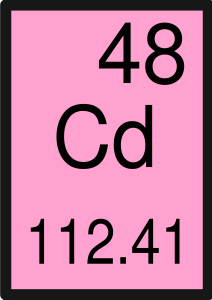Cadmium is an extremely toxic mineral used in a number of industrial operations. Harmful exposure to cadmium typically occurs in the workplace, though individuals can be exposed to this material via contaminated food, water, soil, or cigarette smoke. Industrial workplaces where ore is processed or smelted pose the greatest threat of cadmium exposure. Cadmium poses numerous health risks including cancer and death.
If you or a loved one has suffered adverse health effects caused by cadmium exposure, you may be eligible to seek compensation for your losses and suffering through a civil lawsuit. Please contact us to speak with a cadmium attorney who can  answer your questions, evaluate your claim, and determine whether you may be able to seek compensation through legal action.
answer your questions, evaluate your claim, and determine whether you may be able to seek compensation through legal action.
What is Cadmium?
Cadmium is a natural element found in the earth. It is typically found as a mineral, in combination with other elements, such as cadmium oxide, chloride, sulfate, and sulfide. Because cadmium is highly resistant to corrosion, it is valued in the production of batteries, metal coatings, plastics, and pigments. Most of the cadmium in the United States is extracted during the manufacture of metals such as copper, lead, and zinc.
Who is at risk for cadmium exposure?
Industrial workers are at the greatest risk of suffering injury and illness from on-the-job cadmium exposure. According to the National Occupational Hazard Survey, 1.5 million workers may potentially be exposed to cadmium. Professionals involved with the following industrial operations may be at risk:
- Ore smelting
- Electroplating
- Battery manufacturing
- Welding
- Manufacturing or use of industrial paints
- Scraping or blasting industrial paints for removal purposes
- Producing cadmium soaps, using powdered cadmium oxide, to stabilize plastics
- Calcination or drying of cadmium pigments
- Gas meter repairing and refurbishing
- Repairing, servicing, or maintaining aircrafts
- Production of phosphate fertilizers
- Autobody repair
- Repairing or building ships
The general population may also be at risk for cadmium exposure through eating or drinking cadmium-contaminated foods and water or inhaling cigarette smoke.
How can I be exposed to cadmium?
Cadmium dust particles and fumes can enter the air during industrial applications. Breathing contaminated workplace air is one of the most common means of exposure to cadmium. Cadmium can enter the water or soil from hazardous waste sites. It can also be absorbed in the bodies of fish and other animals. Through these routes, people can be exposed to cadmium through contaminated water or foods (particularly shellfish, kidney or liver meats, artificially colored foods). Exposure to cigarette smoke can double one’s daily exposure to cadmium.
What are the health risks posed by cadmium exposure?
Since cadmium is an extremely toxic material, it poses serious and sometimes deadly health risks. The following are the serious adverse health effects posed by cadmium exposure:
- Severe lung damage: inhaling high levels of cadmium-contaminated air or lower levels over a long period of time can result in serious lung damage and even death.
- Gastrointestinal damage: eating or drinking foods or liquids with high concentrations of cadmium can cause stomach irritation, vomiting and diarrhea.
- Kidney damage and kidney disease: Long-term exposure to low levels of cadmium can result in serious kidney damage or kidney disease.
- Bone damage
- Cancer: the Department of Health and Human Services has concluded that cadmium compounds may pose the risk of cancer
Animals exposed to cadmium have shown additional adverse effects, which may also be risks posed to humans. The cadmium side effects include high blood pressure, liver disease, nerve damage, brain damage, and birth defects.
Cadmium birth defects
Experts are not certain of whether cadmium causes birth defects. However, they do know that cadmium can cross the placenta and can be found in the breast milk of exposed mothers. Animal studies show that cadmium can cause behavioral, developmental, and cognitive birth defects in babies. Cadmium exposure may also result in babies born at a low birth weight.
How do I know if I have been exposed?
Medical tests are available to determine if a person has been exposed to cadmium. Blood tests are able to detect recent exposure to cadmium. Urine tests are able to detect both recent and prior exposure to cadmium. Hair and nail tests may also be performed though the reliability of these tests is less certain.
Cadmium stays in the body for a long time and can build up because of years of low-level exposure to this material.
Does the government regulate permissible levels of cadmium in the environment?
Yes, the Environmental Protection Agency (EPA), Food and Drug Administration (FDA), and the Occupational Safety and Health Administration (OSHA) all regulate the cadmium levels to protect human health.
The EPA limits cadmium levels in drinking water to five parts per billion. Cadmium is not allowed to be present at any level in fertilizers.
The FDA limits cadmium in food colors to 15 parts per million.
The OSHA limits the amount of cadmium in workplace air to 100 micrograms per cubic meter. Permissible levels of cadmium fumes are set at 200 micrograms per cubic meter.
Getting help after suffering a Cadmium Injury or Illness
If you or a loved one has developed health problems or died as a result of cadmium exposure, you may be eligible to seek compensation for your losses and suffering. Those who can be held responsible for cadmium exposure include negligent employers, manufacturers, industrial operators, food manufacturers, and even government entities.
To learn more about your legal rights and options, please contact the qualified cadmium attorneys at The Oshman Firm today. We offer a free no-obligation consultation so that you can get answers to your questions and determine best option for you. Contact Us
